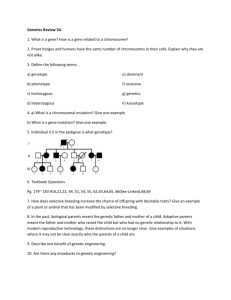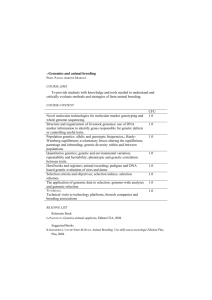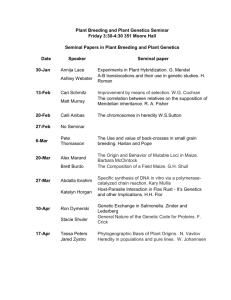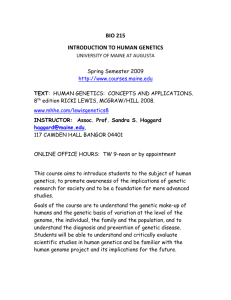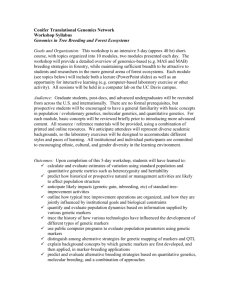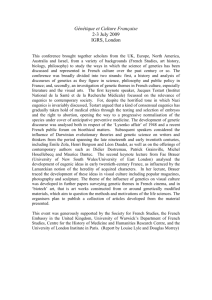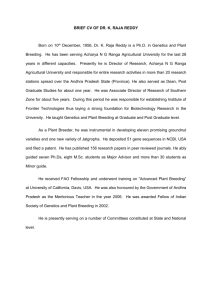Invited Speakers` Titles and Summaries
advertisement
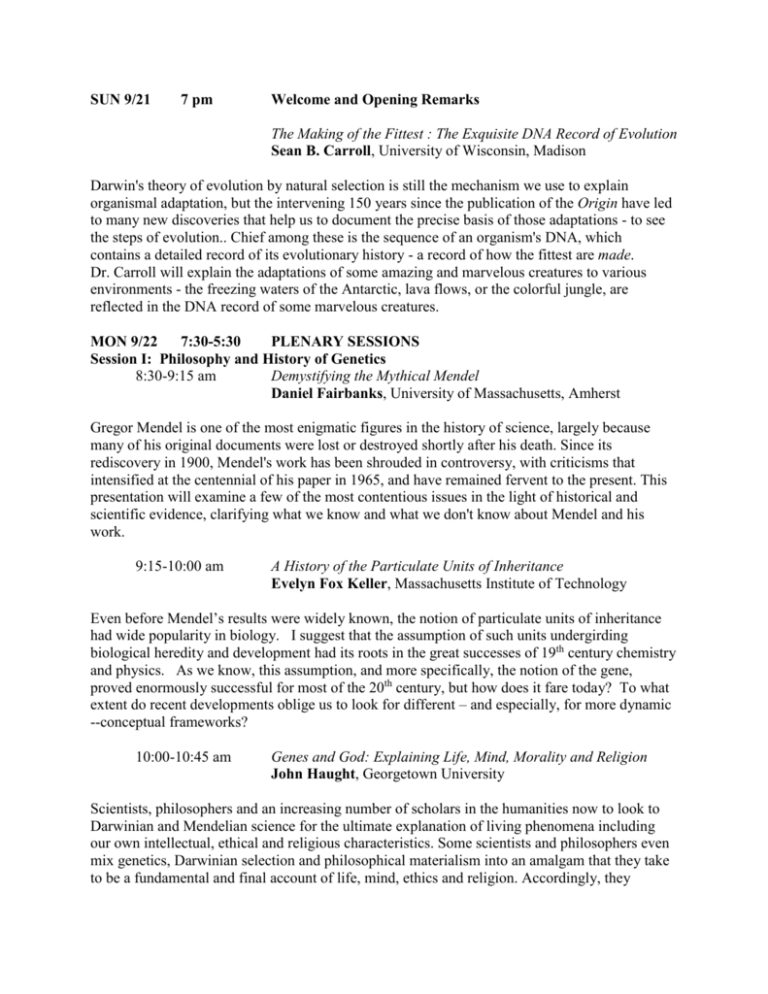
SUN 9/21 7 pm Welcome and Opening Remarks The Making of the Fittest : The Exquisite DNA Record of Evolution Sean B. Carroll, University of Wisconsin, Madison Darwin's theory of evolution by natural selection is still the mechanism we use to explain organismal adaptation, but the intervening 150 years since the publication of the Origin have led to many new discoveries that help us to document the precise basis of those adaptations - to see the steps of evolution.. Chief among these is the sequence of an organism's DNA, which contains a detailed record of its evolutionary history - a record of how the fittest are made. Dr. Carroll will explain the adaptations of some amazing and marvelous creatures to various environments - the freezing waters of the Antarctic, lava flows, or the colorful jungle, are reflected in the DNA record of some marvelous creatures. MON 9/22 7:30-5:30 PLENARY SESSIONS Session I: Philosophy and History of Genetics 8:30-9:15 am Demystifying the Mythical Mendel Daniel Fairbanks, University of Massachusetts, Amherst Gregor Mendel is one of the most enigmatic figures in the history of science, largely because many of his original documents were lost or destroyed shortly after his death. Since its rediscovery in 1900, Mendel's work has been shrouded in controversy, with criticisms that intensified at the centennial of his paper in 1965, and have remained fervent to the present. This presentation will examine a few of the most contentious issues in the light of historical and scientific evidence, clarifying what we know and what we don't know about Mendel and his work. 9:15-10:00 am A History of the Particulate Units of Inheritance Evelyn Fox Keller, Massachusetts Institute of Technology Even before Mendel’s results were widely known, the notion of particulate units of inheritance had wide popularity in biology. I suggest that the assumption of such units undergirding biological heredity and development had its roots in the great successes of 19th century chemistry and physics. As we know, this assumption, and more specifically, the notion of the gene, proved enormously successful for most of the 20th century, but how does it fare today? To what extent do recent developments oblige us to look for different – and especially, for more dynamic --conceptual frameworks? 10:00-10:45 am Genes and God: Explaining Life, Mind, Morality and Religion John Haught, Georgetown University Scientists, philosophers and an increasing number of scholars in the humanities now to look to Darwinian and Mendelian science for the ultimate explanation of living phenomena including our own intellectual, ethical and religious characteristics. Some scientists and philosophers even mix genetics, Darwinian selection and philosophical materialism into an amalgam that they take to be a fundamental and final account of life, mind, ethics and religion. Accordingly, they maintain that this “evolutionary naturalism” amounts to a decisive proof that any theological understanding of living phenomena is now superfluous. This conviction, in fact, provides much of the intellectual foundation of what has come to be called “the new atheism.” By focusing on the question of the evolution of intelligence this lecture will ask whether a gene-centered account of living phenomena, important and informative as it is, can be the ultimate explanation of the human capacity for critical thinking. Session II: Biodiversity and Evolution 11:00-11:45 am The Discovery of Life on Earth David Hillis, University of Texas Phylogenetics (the study of evolutionary relationships) has changed the way biologists think about biology, and have greatly increased our ability to ask evolutionary questions. In addition, databases on the phylogeny of all life are allowing biologists to discover new species and to identify unknown samples of all taxa in a rapid, almost automated fashion. Development of new hand-held devices that can extract DNA, amplify and sequence genes, and place the information into the context of the Tree of Life will advance biodiversity studies rapidly, and allow field biologists (and others) to rapidly discover and identify organisms. Coupled with efforts to develop an Encyclopedia of Life (with web pages and information on every species on the planet), this new technology will greatly increase the relevance and applications of biodiversity studies. 11:45-12:30 Genomes, Brains and Computers: Genetics in relation to the evolution of information storage and processing devices. David Krakauer, Santa Fe Institute Genomes, Brains and Computers have evolved (organically and culturally) to store and respond to environmental regularties that occur at different scales of time and space. From this perspective, we can broaden the study of genetics to include a comparative analysis of important information storage and information processing principles, to include: distributed memory, coding, compression and robustness. Genomes, Brains and Computers all need to be able to preserve and transmit information and then use this information functionally. This requirement can lead to a dichotomy in terms of transmission and processing (inheritance and development), each producing a dedicated technical vocabulary and research program. They are however two necessary components of any information processing system, which together, generate rather widespread principles that are observed across apparently different levels and varieties of organization. Session III: Genomics and Medicine 1:30-2:15 pm Genetics and Genomics for Schizophrenia and Bipolar disorder Pamela Sklar, Harvard University Massachusetts General Hospital TBA 2:15-3:00 pm The Coriell Personalized Medicine Collaborative: An EvidenceBased Study on the Clinical Utility of Personal Genome Information Michael Christman, Coriell Institute The Coriell Personalized Medicine Collaborative (hereafter CPMC) is a research study that will employ an evidence-based approach to determine what personal genome information is clinically useful. A limited subset of genomic data with potential to be medically actionable will be made available to participants and, with their consent, their physicians through a secure web portal. Only validated, reproducible associations that are potentially medically actionable are reported. An Informed Cohort Oversight Board- chaired by National Academy of Sciences Member Dr. Erin O’Shea of Harvard University- is charged with examining evidence provided by CPMC scientists and determining which gene variants have the potential to be actionable. Participants are then asked to take part in a variety of surveys to determine both participant and physician actions and attitudes. Over time, the CPMC will determine how the use of genome data influences health outcomes. The CPMC is led by the Coriell Institute for Medical Research and involves a close association with three major hospital partners- a tertiary care and teaching hospital (Cooper University Hospital), a large community hospital (Virtua Health) and a cancer specialty hospital (Fox Chase Cancer Center). The hospital partnerships are designed to catalyze the education of medical professionals about genomics by encouraging the enrollment of medical professionals in the study. Many of the studies participants are seen at these hospital partners. The overall goal of the CPMC study is to examine the utility of using genome information in clinical decision-making in an evidence-based manner. The study will enroll 10,000 participants by the end of 2009. Session IV: Ethical, Legal, and Social Impact of Genetics 3:15-4:00 pm Genetics and the Human Future: The View from Twenty Years of ELSI Thomas Murray, Hastings Center The moral and political doctrine that “All (persons) are created equal” was never meant as a claim of biological identity. In appearance, speech and conduct, we find eloquent testimony to the vast varieties of ways to be human. Our genes contribute to this variety. Information about an individual’s genes is fast becoming cheap and easy to obtain—a consequence of the Human Genome Project. What uses can be made of genetic information and what should be our concerns? Genome research is also giving us new tools for altering human form and function. What are the implications of such genetic manipulations? And what does it mean for society when genetic explanations are offered for complex social patterns and practices? I first asked these questions in 1988 in response to a Congressional request. Twenty years later, it is worth reflecting on what has happened, and on what the future may hold. 4:00-4:45 pm The End of Behavioral Genetics? Matthew McGue, University of Minnesota At its founding, Psychology had a decidedly Darwinian focus. Yet the association of early behavioral geneticists with the eugenics movement led many to reject biological accounts in favor of so-called “Blank Slate” models of human behavior. Twin and adoption research from the latter half of the 20th century proved a powerful antidote to the radical environmentalism that dominated within some areas of psychology earlier in the century. But once we have accepted that behavior has a heritable component, is there anything left for behavioral geneticists to say? It will be argued that behavioral genetic research will continue to make fundamental contributions to psychological knowledge primarily in two ways: 1) by facilitating the search for genes affecting individual differences in behavior, and 2) by modeling the role of geneenvironment interplay in psychological development. Progress with respect to the first goal has been unexpectedly slow, apparently because any single genetic polymorphism has at most a small marginal effect on behavior. Progress in the second area, although more marked, is challenged be the need for innovative research designs that allow factors that are normally confounded to be “pulled apart”. Illustrations of both approaches from contemporary behavioral genetic research will be provided, with a particular focus on adolescent development. 4:45-5:30 pm How Art and Literature Can Contribute to Genetic Policy Lori Andrews, Chicago-Kent College of Law Novelists and artists increasingly work in the genetics realm and the themes in their art and fiction could be used as a basis for public policy. The types of policies suggested by art and fiction include: the need for public involvement in choices about genetics; the design of technology to meet actual needs; the development of a mechanism for collecting data about unintended consequences; the concern about diminishing people through genetic technology; the amelioration of social and relationship risks caused by genetic engineering; the protection of genetic privacy; and the need for enforcing an ethical standard for caring and responsibility. MON 9/22 7 PM EVENING LECTURE Opening Remarks Confronting Paley’s Ghost: Charles Darwin and the Evolutionary Design of Life Kenneth Miller, Brown University Evidence supporting the theory of evolution is pervasive in all fields of biology, and enables us to place the origin of our species in its proper scientific context. Nonetheless, evolution itself remains controversial, and is widely seen as embracing a philosophical worldview that many Americans find objectionable. As a result, political forces continue to pressure public officials to endorse alternatives to evolution, including “creation science” and “intelligent design.” I will address the aspects of evolution that seem to provoke such responses, and will suggest that the science of Darwinian evolution can be understood in a way that should lead to a reduction in the conflicts between science and religion in society. TUES 9/23 7:30-11:45 PLENARY SESSIONS Session V: Biotechnology and Pharmaceutical Industries 8:30-9:15 am Drug development in the genomic era: Can modern genetic tools revolutionize the development of new medicines? Nicholas Dracopoli, Johnson and Johnson Five years after the completion of the human genome sequence, most drugs are still be developed without comprehensive molecular profiling to optimize dose or treatment schedule, measure impact on the drug target and its biological pathway or to select patients most likely to benefit from therapy. Why is this? What are the limitations of genomic technologies, and what are the main obstacles preventing more widespread implementation of genomic technologies in modern drug development? This presentation will describe how genetics may be applied on a genomewide scale to the development of new drugs, and how we may expect to see a gradual transition from one-size-fits-all blockbuster drugs to more individualized approaches to treatment through the broader implementation of novel predictive and prognostic biomarkers. 9:15-10:00 am The Rotovirus Vaccine Developed at CHOP Paul Offit, Children’s Hospital of Pennsylvania The speaker is the co-inventor of the rotavirus vaccine recently licensed by the Food and Drug Administration and recommended for routine use in all U.S. children. The burden of rotavirus disease, previous failed efforts to make a rotavirus vaccine, and the genetic approach used to make the current rotavirus vaccine will be discussed. Session VI: Genetics, Agriculture and Global Sustainability 10:15-11:00 am Twenty-first Century Agriculture and the Challenges of Sustainability Michael Schechtman, United States Department of Agriculture Assuring an adequate world food supply while addressing critical environmental needs will be a major challenge of the coming century, with population pressure, finite land resources, and climate change as key drivers for decision-makers. Over the last decade, agriculture has changed rapidly as new plant varieties produced through genetic engineering have been adopted at an unprecedented rate by farmers in many countries. At the same time, technology advancements have led to breakthroughs in the ability to understand and utilize the genetic potential of key crop species with new methods that reinforce the power of traditional crop breeding methods. USDA is taking a leadership role in identifying and cataloguing useful traits contained in its germplasm collections vital to supporting the world food, fuel, and fiber supplies. Bringing new agricultural innovations to farmers who will require them, especially in poor developing countries, is challenging, and is complicated by an ongoing dialogue about what would be required to do it in a sustainable manner. There are new efforts to establish markers and indicators for sustainable agriculture. However, international debates on the meaning of sustainable development and the use of new agricultural technologies by poor farmers have often been heated. Recently we are witnessing are encouraging efforts toward development of new crops meeting the needs of poor farmers and movement by some developing nations toward incorporating modern technologies in their development strategies. USDA, through support of U.S. farmers utilizing a broad range of agricultural approaches and through public dialogue around key issues affecting the future of agriculture here and in other countries, is helping to understand emerging agricultural trends and prepare for future needs. 11:00-11:45 am Developing Plant Breeding Capacity to Meet Global Challenges in Sustainable Agricultural Production Vernon Gracen, Cornell University Department of Plant Breeding and Genetics Changes in climatic conditions are bringing new challenges to agricultural production. The development of crops for bio-energy is creating new opportunities and challenges for the agricultural sector. Food prices are soaring. All of these factors are calling attention to plant breeding, an area of applied science that has been neglected in the recent decades. Plant breeding was established as a discipline in the last century after the rediscovery of Mendel’s principles of genetics. It is essentially the science of improving the heredity of plants for the benefit of humankind. New scientific discoveries, technology development and knowledge integration continues to strengthen the knowledge base for food and agriculture development at an unprecedented rate, offering improved paradigms for sustainable production and agroecosystems management. Plant breeding is an essential part of this process, as better adapted crop varieties, in association with improved production systems, are essential to help tackle most of the new and emerging challenges to agricultural systems. However, national capacities in plant breeding and crop improvement, using conventional and modern methods, are neither sufficient nor properly integrated to meet today’s challenges to sustainable food production in most developing countries. Unfortunately, the role of plant breeding in agricultural development was taken for granted by governments and donors over the past decades, leading to a sharp decline in the national capacity to develop new varieties in many developing countries. The limitations in trained personnel, institutional weaknesses and inefficiencies within the plant breeding sector and in its links with seed systems are key elements that prevent sustainable improvement in food security. Efforts to alleviate this situation are underway. A new concept for training plant breeders in Africa working with African crops and constraints in African environments was established at the University of Kwa-Zulu Natal in South Africa 6 years ago. The African Center for Crop Improvement (ACCI) was established to train Ph.D. plant breeders from Eastern and Central African countries. The West Africa Center for Crop Improvement (WACCI) was established last year at the University of Ghana to train West African plant breeders. The goals of both centers are to develop plant breeders with the skills needed to improve food security in Africa. A similar program is being developed in Thailand to train SE Asian plant breeders. In addition, the Global Partnership Initiative for Plant Breeding Capacity Building (GIPB) was launched in June, 2006. GIPB is an international partnership of public, private and civil society sectors working to enhance professional and institutional plant breeding capacity in support of crop production intensification, food security and sustainable development. GIPB’s goal is to strengthen the capacity of developing countries to improve their productivity through the sustainable use of plant genetic resources for food and agriculture using better breeding and seed delivery systems.
